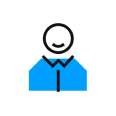AVL Cable Guide: Common Cable Types
Posted by Laura Strommen - SoundPro on Jul 12th 2024
Estimated Reading Time: 8 Minutes
Cables are an underappreciated yet essential part of any audio, visual, or lighting setup. You can buy the finest gear available, but the results will disappoint if it’s connected to a cable that doesn’t properly transmit a signal. Avoid this scenario, connect with confidence, and enhance your gear’s performance when you pair your AVL gear with cables that optimize the signal and give you the best results.
THE TYPICAL ANATOMY OF A CABLE
Inside a cable are layers of delicate materials that work together to ensure your electronic signal gets where you need it to go.
- 1. At the cable’s center is a core (or conductor) of conductive signal wire or wires. This core transmits electronic signals from an input source to an output source—for example, an electric guitar to a loudspeaker.
- 2. The core is generally encased in an electrostatic shield of rubber or other insulating material.
- 3. Next comes a layer of shielding comprised of braided wires or foil. Shielding protects the signal and prevents handling noise, shorts, and other bad things you don’t want to happen when using your electronics.
- 4. Around this shielding is the outer jacket of the cable.
While this configuration describes the most common way a cable’s cross-section is laid out, other cables may share the same basic parts but may be assembled in a different configuration so the cross-section looks different.
COMMON AVL CABLE TYPES
Anywhere you have an AVL setup probably uses multiple cable types to connect audio sources, video equipment, and light fixtures. From live productions to houses of worship and educational spaces to permanent installations for businesses and other venues, cables are unsung heroes that can make or break the success of the AVL experience.
Audio Cables
Instrument cables connect electronic instruments such as guitars, basses, keyboards, and drum kits to speakers, amplifiers, or mixers. Musicians who take pride in the quality of their instruments will want to invest in a cable that accurately reflects this quality.
Whether you’re a singer, speaker, musician, or anyone else capturing audio for live or recorded productions, likely a microphone is central to your setup. Do your sound justice with microphone cables that faithfully transmit every detail and nuance.
Speakers are essential for achieving an immersive sound experience for live shows, recording studios, audio editing, and more. Because of this, speaker cables are crucial to ensuring your speakers work their best.
Balanced and Unbalanced Audio Cables
Sometimes referred to as asymmetrical or single-ended (SE) cables, unbalanced audio cables are constructed using two wires: a ground wire, which acts as a shield to protect against electrical fire, and a signal (or “positive”) wire that passes the audio signal in one direction, transmitting the signal directly through to the gear it’s connected to without any changes or adjustments.
Types of Unbalanced Cables:
TS - Short for Tip and Sleeve, this connector type sends the audio signal through its tip, while the ground signal is sent through the sleeve portion. Also referred to as 1/4-inch connectors, these unbalanced cables are usually no longer than 15 feet to minimize interference.
RCA - Named after the Radio Corporation of America, RCA connectors are also known as phono connectors and are common in stereo equipment for home audio systems. These unbalanced cables are usually limited to 25 feet long.
Unbalanced cables are susceptible to picking up interference from other electrical sources, which can distort the final sound. Because of this, unbalanced cables are best used in short-distance, non-professional applications such as home audio setups.
Although unbalanced cables are less expensive than balanced cables, you’ll need additional gear such as a direct (or DI) box to connect it to gear that requires a balanced signal, negating any savings you might have when purchasing the cables.
In contrast, balanced (or symmetrical) audio cables feature three wires: a ground wire for shielding and two signal wires—one positive signal, and one negative signal wire—that cancel out electrical interference to deliver better quality. This makes balanced cables ideal for professional audio setups where the cable runs tend to be longer, such as live audio projects, recording studios, film sets, and more.
Types of Balanced Cables:
XLR - Fudging the abbreviation from External Line Return, this three-pronged connector comes in male and female types. A primary example of a balanced cable, XLR is a typical connector type for professional audio equipment such as microphones and can send a pristine signal up to 200 feet away.
TRS - Short for Tip, Ring, and Sleeve (sometimes called a jack plug), this connector is commonly found in headphone equipment. It’s compatible with 3-pin XLR, and can be used when physical space is at a premium. But be careful—TRS is also used for unbalanced stereo connections, such as professional headphones. You can visually differentiate TRS from its TS counterpart by counting the rings on the connector: TS has only one ring, whereas a TRS cable will have two rings.
- Hosa 1/4 TRS to Same Balanced Interconnect Cable
- Hosa Pro REAN 1/4 TRS to Same Balanced Interconnect Cable
- Hosa Pro REAN 1/4 TRS to XLR3M Balanced Interconnect Cable
- Hosa Pro REAN XLR3F to 1/4 TRS Balanced Interconnect Cable
- RapcoHorizon NBLC MS 1/4 to XLRM Balanced Line Cable
- RapcoHorizon SBLC Balanced Line Cable
In general, balanced cables are the better—if more expensive—choice for most applications. That said, always check the compatibility of the gear you’re connecting, and consider the cable run distance, before making a final decision.
Audio Snakes
For situations where you have multiple connections to make across your space, an audio snake may be the solution for streamlining your cable run. A snake is a bundle of cables that split off to enable connectivity to different equipment. Great for reducing mess onstage and simplifying set-up and teardown, they’re ideal for permanent and portable applications alike, from outdoor music festivals to houses of worship, entertainment venues, and more.
Lighting Cables
Cables for lighting, (such as DMX, etherCON, and more) are ideal for any wired lighting application—including installed lighting for stages or studios, houses of worship, performance and entertainment venues, or mobile entertainer gig rigs.
Note: DMX cables can utilize 3- or 5-pin XLR connectors, but the wire itself is different than XLR audio cables. DMX offers higher fixed impedance, which is critical for digital signals used in lighting applications.
Video Cables
Video signals are constant and require consistency, reliability, and accuracy in their transmission. That’s where video cables come in, offering quality and durability that allow you to record or broadcast your images confidently.
Two common types of video cables are SDI and HDMI. SDI (Serial Digital Interface) is standard for transmitting raw digital signals over a long distance, and is categorized into 3G, 6G, 12G, and so on to distinguish how many gigs of data a particular cable can transmit per second.
While SDI is less expensive, HDMI (High-Definition Multimedia Interface) is able to transmit both audio and video signals, which makes it a more flexible option for some applications.
CONCLUSION
For more information about cables, snakes, as well as accessories, connectors, and adapters to further customize your connectivity, reach out to the SoundPro experts at info@soundpro.com or 800.203.5611.

Laura Strommen – Content Writer
Laura earned a BA in English at the University of Wisconsin – Whitewater and has been part of the SoundPro team since 2021.






